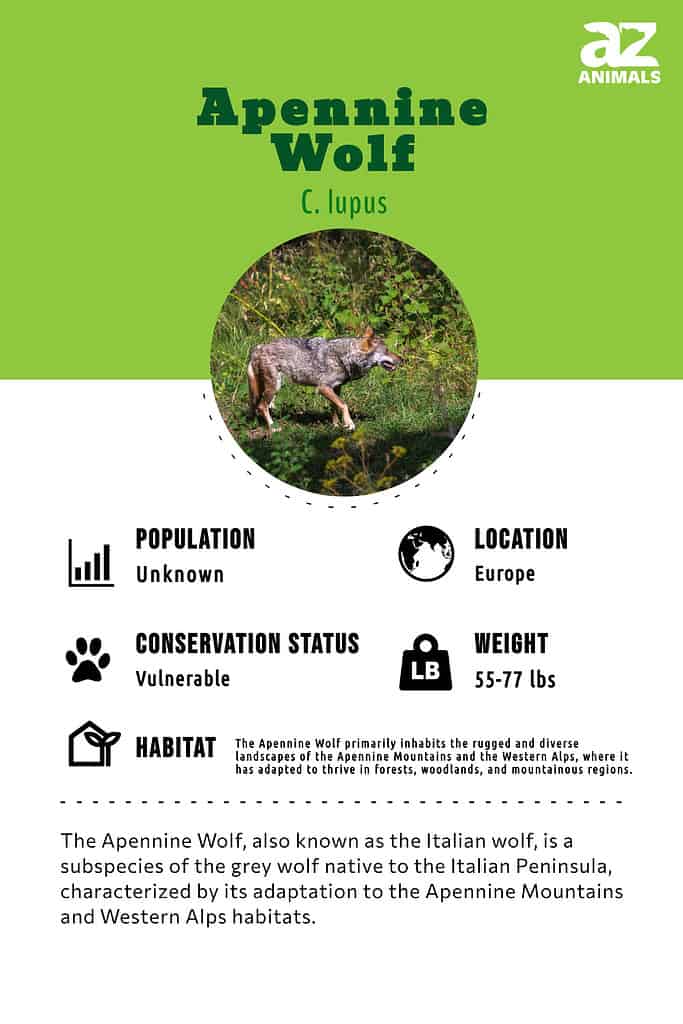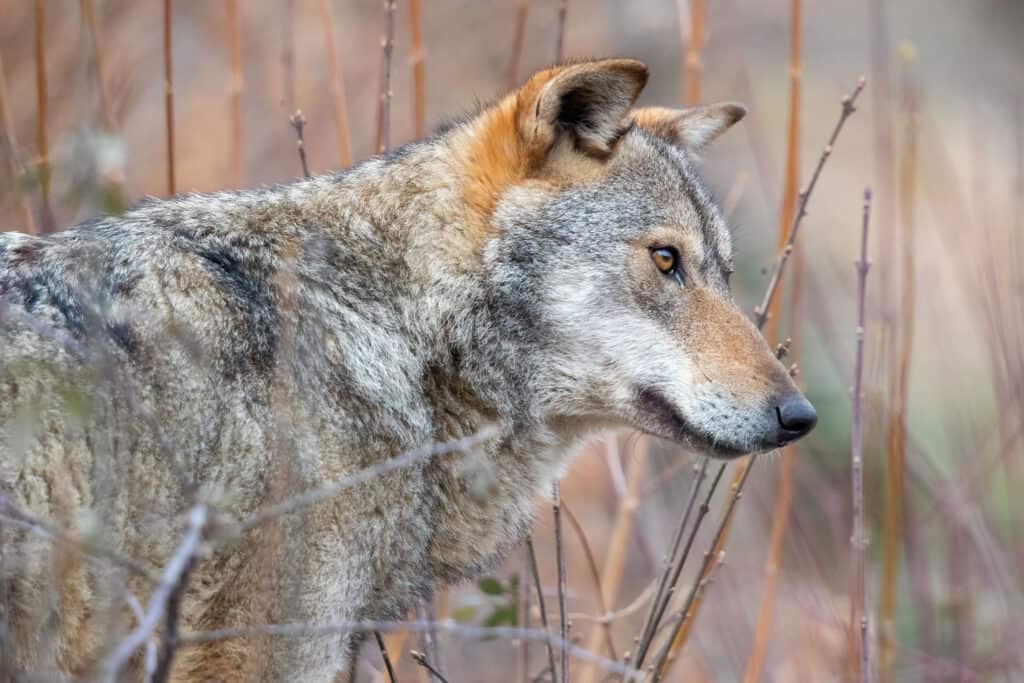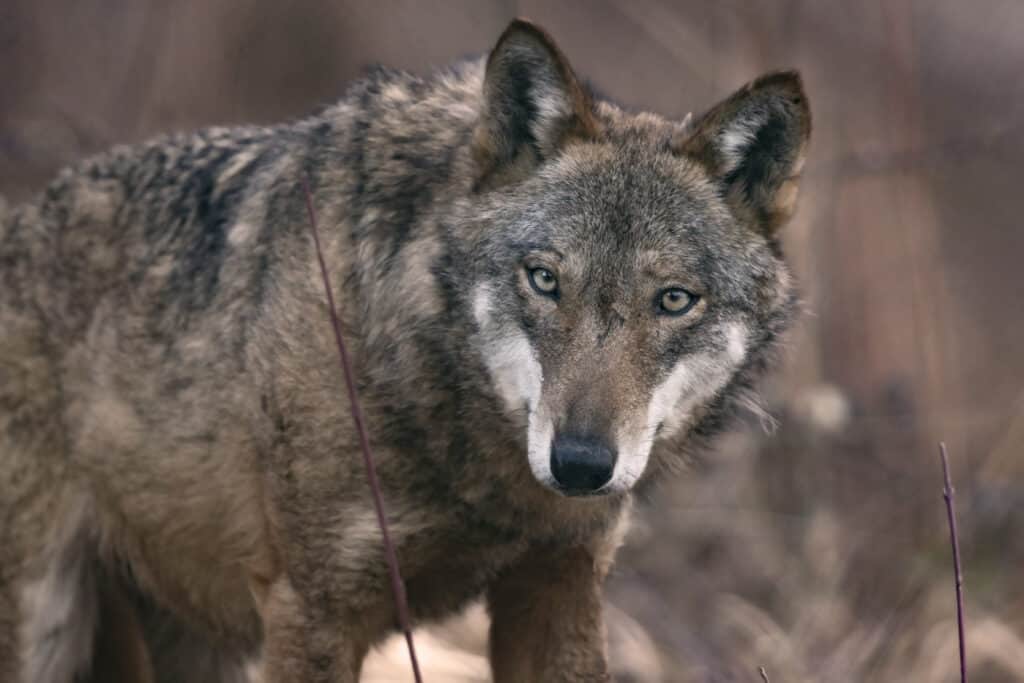Apennine Wolf
C. lupus
Wolves do not howl at the moon. They howl to communicate with other members of their pack.
Advertisement
Apennine Wolf Scientific Classification
- Kingdom
- Animalia
- Phylum
- Chordata
- Class
- Mammalia
- Order
- Carnivora
- Family
- Canidea
- Genus
- Canis
- Scientific Name
- C. lupus
Read our Complete Guide to Classification of Animals.
Apennine Wolf Conservation Status
Apennine Wolf Facts
- Prey
- Deer, wild boar, chamois
- Main Prey
- Deer
- Name Of Young
- Pup
- Group Behavior
- Pack
- Fun Fact
- Wolves do not howl at the moon. They howl to communicate with other members of their pack.
- Estimated Population Size
- 3,300
- Biggest Threat
- Illegal hunting by humans to protect livestock.
- Most Distinctive Feature
- Greyish-brown, white and black fur, turning reddish in summer.
- Distinctive Feature
- About the size of a German Shepherd
- Other Name(s)
- Italian wolf
- Gestation Period
- 2 months
- Temperament
- Territorial, aggressive
- Age Of Independence
- 1-5 years
- Litter Size
- 2-8
- Habitat
- forest
- Predators
- Wolves, humans
- Diet
- Carnivore
- Average Litter Size
- 2-8
- Lifestyle
- Nocturnal
- Favorite Food
- deer
- Common Name
- Italian wolf
- Special Features
- Greyish-brown, black, and white pelt, turning reddish in the summer.
Apennine Wolf Physical Characteristics
- Color
- White
- Black-Brown
- Grey-Brown
- Lifespan
- 10 years
- Weight
- 55-77 pounds
- Height
- 20-28 inches at the shoulder
- Length
- 43-58 inches long
- Age of Sexual Maturity
- 3 years
- Age of Weaning
- 3 months
- Venomous
- No
- Aggression
- High
View all of the Apennine Wolf images!

Interesting Fact
“According to legend, an Apennine wolf raised the twin brothers who founded Rome.”
Summary

Wolves will kill and eat boars.
©iStock.com/Ciro de Simone
The Apennine wolf is also known as the Italian wolf and is the unofficial national animal of Italy. It is native to the Apennine Mountains and the Western Alps. It nearly went extinct in the 1970s due largely to illegal hunting, but after strict protections were put in place, its numbers have grown. There are now over 3,300 of them and they have begun to spread into southeastern France and Switzerland.
Apennine Wolf Facts
- The Apennine wolf is the unofficial national animal of Italy.
- They almost went extinct in the 1970s but are rapidly multiplying today.
- It’s not clear whether they are a separate species or a type of the Eurasian wolf.
- Apennine wolves can eat up to 6.5 pounds of meat a day.
- They do not howl at the moon. They howl to signal danger to their pack or while hunting.
Scientific Name

Recognized as the Italian wolf, the Apennine wolf holds the status of an unofficial national animal in Italy.
©iStock.com/Gennaro Leonardi
The Apennine wolf is also known as the Italian wolf. Its scientific name is Canis lupus italicus. In Latin, “canis” means “dog,” “lupus” is “wolf,” and “italicus” means “Italian.” Apennine wolves are of the Mammalia class and the Canidae family. In Italian the common name of this wolf is “lupo.”
There has been some controversy over whether the Apennine wolf is a distinct subspecies of the common Eurasian wolf, Canis lupus lupus. Some sources list them separately; others consider them the same species.
Appearance
Members of this wolf species are about the size and weight of German shepherds. They may weigh 55-77 pounds, although male specimens have reached 99 pounds. Their bodies are 43-58 inches long and 20-28 inches high at the shoulder.
Their fur is grey, brown, white, and black. The stomach and cheeks have lighter colors, while the back and tail are the darkest part of the pelt. In the summer they take on more of a reddish hue.

Apennine wolf fur is grey, brown, white, and black.
©iStock.com/Ciro de Simone
Evolution and Origins
The Apennine wolf, scientifically known as Canis lupus italicus or Canis lupus lupus, is a subspecies of the grey wolf that is indigenous to the Italian Peninsula.
It primarily occupies the Apennine Mountains and the Western Alps, although it is gradually extending its range towards the northern and eastern regions.
Around 1 million years ago, during the height of the Ice Age, wolves emerged from a lineage of smaller canid species native to Eurasia, evolving into the magnificent creatures we know today.
Although the complete evolutionary history of the wolf remains somewhat uncertain, numerous biologists posit that the wolf likely originated from primitive carnivorous mammals called miacids, which varied in size from gopher-sized to dog-sized creatures and first emerged during the Lower Tertiary approximately fifty-two million years ago.
Behavior
Apennine wolves live in packs of anywhere from two to a maximum of 12 animals. Compared to other wolf species, they run in smaller packs due to a lack of large prey in their habitat. After deer were reintroduced into Italy’s Abruzzo National Park, however, larger packs of six to seven wolves began to appear.
Wolves communicate with one another with barks, howls, yips, growls, whines, and other vocalizations, as well as body language, scent, touch, and taste. It is a myth that wolves howl at the moon.
Instead, they howl to gather the scattered pack before and after hunts, to sound an alarm, to locate one another in new territory, and to communicate over a distance. A wolf’s howl can travel over a territory of 50 square miles in the right circumstances.
Socialization
The social behavior of wolves within their packs is complex and interesting. Wolves are very social creatures that form close ties with one another and are highly territorial and protective of their families. They usually claim a larger territory than they actually need for their survival in order to make sure they have a steady supply of prey. They try to avoid hunting near the edges of their territory to avoid conflicts with other packs.
Packs include an alpha pair and their offspring who stay with them until they are old enough to find their own mates, which can be as short as 10 months or up to nearly five years. Competition for mates and food is the main reason they disperse rather than making ever-larger packs. Wolves may travel 100 miles or more away from their families to start their own packs. They hardly ever adopt non-related wolves into their packs; they kill them instead. “Lone wolves” driven out of their packs may remain solitary.
The ability of wolves to cooperate is one of the keys to their success as a species. They collaborate on vital activities, such as hunting and defending territory from other wolves. Each member of the pack has a role to play, from the leading alphas to more gregarious or submissive members. Dominant and aggressive wolves move slowly, walk with their body held high, and raise their hackles. In their presence, submissive, lower-status wolves keep their bodies low, their fur flat, and their ears and tail lowered.
Habitat
The preferred habitat of this species is the forest, including coniferous forests at higher elevations and temperate broadleaf and mixed forests, to the Mediterranean forests and scrublands of the warmer south.
Wolves construct dens in the summer using natural features like rock outcroppings, overhanging riverbanks, and vegetation-covered holes. They may even steal and enlarge a burrow from a smaller animal, such as a fox, badger, or marmot. Wolves prefer dens near a water source and facing south to get more warm sunlight exposure.
Diet
In its habitat, the Apennine wolf is the apex predator. They are carnivores, eating up to 6.5 pounds of meat a day. They hunt nocturnally for various species of deer, wild boar, and chamois (a species of goat-antelope). When they cannot find larger prey, they hunt hares, rabbits, birds, and even invertebrates. Near settled areas, they will prey on sheep, goats, calves, horses, and other livestock. They are also scavengers, prone to eating carcasses or edible bits of human garbage. They occasionally eat berries and herbs for roughage.
Predators, Threats, and Conservation Status
Since these wolves are apex predators in their territory, other species do not hunt them. Their biggest natural threat is one another, with territorial fights being one of their leading causes of death.
Human beings are the greatest threat to the survival of this species. This is a result of fear and, in the past, superstition. Medieval records indicate wolves attacked hundreds of Italians from the 15th-19th centuries. However, no attacks were recorded after World War II. In the 1920s, many rural people still believed in werewolves. They would not sleep facing the full moon for fear they would transform into wolves. These kinds of fears led to the killing of enormous numbers of wolves.
However, one of the main reasons for the hostility of humans toward wolves is the threat they pose to livestock, which can be easier prey for them than hunting wild game. In France, to reduce the number of unfavorable interactions between wolves and farmers, the government has subsidized electrified pasture fencing and night pens, hired additional farm hands, and purchased, trained, and upkeep of livestock guard dogs. Despite these measures, some livestock owners still illegally kill wolves when they stray onto their property.
The current conservation status of the Apennine wolf is “vulnerable.” The species nearly went extinct in the 1970s due largely to illegal hunting, but after strict protections were put in place, its numbers have grown. The most recent estimates are that 3,300 of them live in Italy and they have begun to spread into southeastern France and Switzerland. Apennine wolves are now protected in all three countries and their numbers are growing.
Reproduction, Babies, and Lifespan
Wolves mate for life, but if one of them dies, the survivor finds a new mate quickly. Mating occurs in March with a two-month gestation period. Females may give birth to between two and eight pups, depending upon the age of the mother. They usually just have one litter a year.
Italian wolf pups weigh 8-12 ounces, about the same as a glass of water or a can of soda. They are blind, deaf, and covered in gray-brown fur at birth. They start opening their eyes at nine to 12 days old. They leave the den after three weeks but continue drinking their mother’s milk until they are 30-45 days old.
At three to four months, they can digest meat. They become sexually mature at about three years old. The whole pack helps protect the young, keeping them in a den at the center of their territory.
In the wild, Apennine wolves can live up to about 10 years. In captivity, wolves can live for 15 years or more.
Population
The Apennine wolf population in Italy is estimated at 3,300 individuals. Most of this population—about 2,000 animals—is distributed across the central and southern portions of Italy. They are multiplying most rapidly in the Alps of northern Italy. From there, they have been steadily spreading into France and Switzerland.
View all 194 animals that start with AApennine Wolf FAQs (Frequently Asked Questions)
Where does the Apennine wolf live?
They live mainly in the central and northern mountains of Italy, but are spreading into France and Switzerland.
What does the Apennine wolf eat?
In the wild its favorite foods are deer, wild boar, and chamois. It also likes smaller animals, like rabbits or birds when it can catch them. It will raid farms to steal livestock and will also eat abandoned carcasses and garbage.
Can Apennine wolves breed with domestic dogs?
Yes, all dogs descend from wolves and are able to interbreed with them. This may occasionally happen in the wild between a domestic or feral dog and a wolf. However, the more usual outcome would be a fight, sometimes to the death. Sometimes people breed wolves and dogs to create hybrid puppies. These may retain many of the wild instincts of their wolf parent.
Thank you for reading! Have some feedback for us? Contact the AZ Animals editorial team.
Sources
- Wikipedia.org Italian Wolf, Available here: https://en.wikipedia.org/wiki/Italian_wolf
- Wikipedia.org Wolf, Available here: https://en.wikipedia.org/wiki/Wolf
- Animal Corner, Available here: https://animalcorner.org/animals/italian-wolf/
- International Wolf Center, Available here: https://wolf.org/wow/europe/italy/
- The Wolf Intlligencer, Available here: https://thewolfintelligencer.com/italian-wolf-canis-lupus-italicus/
- Ecotur, Available here: https://www.ecotur.org/en/apennine_wolf.xhtml
- Wanted in Rome, Available here: https://www.wantedinrome.com/news/italys-wolf-population-rises-to-3300.html

















